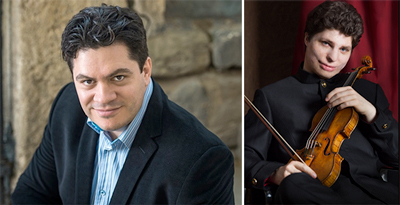by Daniel Hathaway

The big draw, of course, was Gustav Holst’s The Planets, but the audience was just as attentive to — and seemingly as thrilled by — Antonín Dvořák’s Violin Concerto in the first half of the program.
Not so frequently heard as other violin showpieces, the Concerto is something of a strange animal. It begins with bold orchestral gestures that threaten to overpower the responses from the soloist, then wanders however charmingly through a succession of lyrical melodies without a clear architectural purpose. The best of those are generally Czech-sounding, and with Dvořák, a folk dance is often just on the verge of breaking out.
Hadelich played both forcefully and sweetly, singing out high lines and showing off his fine technique in some passages that resembled etudes. His dialogue with a pair of horns playing in thirds at the end of the second movement was especially lovely. The catchy finale, finally a real furiant, brought the Concerto to a merry conclusion that had the audience on its feet.

Măcelaru and the Orchestra gave Holst’s astrological suite a stunningly paced, flawless performance from the hair-raising brutishness of “Mars, The Bringer of War” right through to the veiled mystery of “Neptune.”
Holst was a trombonist, and the heritage of British brass bands inspired many of the composer’s orchestrational decisions, but The Planets also fields a number of exotic instruments for its special effects. Bass flute, bass oboe, and tenor tuba all contribute special moments to the score, and Holst’s two independent harp parts and clever use of percussion and organ (with its rumbling 32-foot stops) lend extra detail to the texture. Every section of the Orchestra distinguished itself.
The most atmospheric effect is the offstage female chorus, who add an extra halo of mystery to the final moments of “Venus.” The thirty women’s voices of the Blossom Festival Chorus, including some members of the Cleveland Orchestra Youth Chorus, sounded weightlessly wonderful, their gradual decrescendo to nothingness allowing for a long moment of pure silence at the end.
Presiding over all of these planetary images was a sliver of moon, almost the reverse image of the partial solar eclipse early in the week.
Published on ClevelandClassical.com August 29, 2017.
Click here for a printable copy of this article



